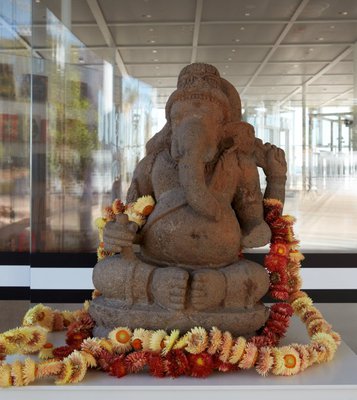-
Details
- Other Title
- Ganesha
- Place where the work was made
-
Central Java
→
Java
→
Indonesia
- Date
- 10th century
- Media category
- Sculpture
- Materials used
- volcanic stone
- Dimensions
- 67.0 x 40.0 x 35.0 cm
- Signature & date
Not signed. Not dated.
- Credit
- Anonymous gift 1985
- Location
- Entrance Pavilion
- Accession number
- 178.1985
- Copyright
- Share
-
-
About
The most common account of how Ganesha obtained his elephant head relates to the occasion when Ganesha, then a handsome youth created by Parvati from the slough of her skin, was decapitated by Shiva's hordes ('gana') when Ganesha, on Parvati's instructions, barred Shiva from entering her apartment. To appease Parvati's anger at the loss of her son, Shiva sent out his followers with instructions to sever the head of the first living creature they encountered which was an elephant. Ganesha has become one of the most popular of the Hindu gods. In this image, his corpulent body sits on a double lotus throne with the soles of his human feet touching. This pose, unknown in India, is unique to Java and Cambodia. The snake coiled around the sacred thread across his chest, the elaborate headdress with a crescent moon and a skull, as well as the vertical third eye in the centre of his forehead, all indicate his close association with the Hindu god Shiva. Of his four arms, his front right hand holds his broken tusk; his front left hand (now missing) would have held a bowl full of rice, sweets or jewels, while his two posterior hands would have held an axe and a fly whisk.
In Shaivite temple complexes of Central and Eastern Java where the Siva image (or lingam) would occupy the central niche and face west, his elephant headed son, Ganesha would sit opposite him. Statues of Ganesha, who was honoured as the remover of obstacles, were also found on dangerous sites such as river crossings, ravines and slopes of volcanoes.
-
Places
Where the work was made
Central Java
-
Exhibition history
Shown in 2 exhibitions
Walking with gods, Art Gallery of New South Wales, Sydney, 01 Jun 2019–05 Jan 2020
SMP Interstitials, Art Gallery of New South Wales, North Building, Sydney, 03 Dec 2022–01 Sep 2023
-
Bibliography
Referenced in 10 publications
-
Art Gallery of New South Wales, Art Gallery of New South Wales Annual Report 2004, Sydney, 2004, 17 (colour illus.).
-
Bruce James, Art Gallery of New South Wales handbook, 'Asian Collection: South-East Asia', pg. 298-301, Sydney, 1999, 301 (colour illus.).
-
Jackie Menzies (Editor), The Asian Collections Art Gallery of New South Wales, Sydney, 2003, 11 (colour illus.).
-
Jackie Menzies and Edmund Capon AM, OBE, Asian Collection Handbook, Art Gallery of New South Wales, 'South-East Asian Art', pg. 83-96, Sydney, 1990, 87 (illus.).
-
Jackie Menzies, AGNSW Collections, 'Asian Art - India, South-East Asia, China, Tibet, Korea, Japan', pg. 173-228, Sydney, 1994, 186 (colour illus.).
-
Jacqueline Menzies, Art Gallery of New South Wales handbook, 'Asian', pg. 72-93, Sydney, 1988, 90, 91 (illus.).
-
Public Programmes Department, Art Gallery of New South Wales, Adventures in Asia. An education kit for the Asian gallery, Sydney, 2003, 15 (colour illus.). card no.15
-
Jill Sykes (Editor), Look, Sydney, Dec 2003-Jan 2004, 9 (colour illus.).
-
Bronwyn Watson, Look, 'Network for Asia', pg. 20-21, Melbourne, Apr 2001, 21 (colour illus.).
-
Judith White, Look, 'The myth of Ganesha', pg. 17, Melbourne, May 1999, 17 (colour illus.).
-
-
Provenance
Private Collection, 1960s-Aug 1985, Sydney/New South Wales/Australia, purchased in Sydney in 1960s. Donated to the Art Gallery of New South Wales, Sydney, 1985.

